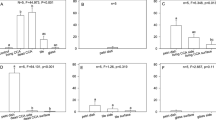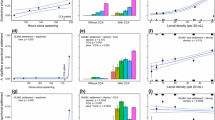Abstract
The adults of many coral reef fish species are site-attached, and their habitat is selected at the time of settlement by their larvae. The length of the planktonic larval period varies both intra- and interspecifically, and it is unknown how the age and size of larvae may affect their selection of habitat. To investigate the influence of age and size on habitat selection, I collected newly settled Hawaiian domino damselfish, Dascyllus albisella, daily from grids containing three coral species at four locations in Kaneohe Bay, Oahu, Hawaii. I recorded the coral species each fish was collected on, and measured and aged (by otoliths) the collected fish. The results indicate that the coral Pocillopora meandrina was selected by settling fish significantly more than the other two coral species. Younger and smaller larvae selected this coral species more frequently than older/larger larvae. In addition, younger/smaller individuals were found more commonly inside the bay than older/larger settling larvae. Differences in the choice of coral species and location of settlement may be partly due to ontogenetic differences in the sensory capacities of larvae to detect corals, conspecifics, and predators, or to a larval competency period.
Similar content being viewed by others
References cited
Aldenhoven, J.M. 1986. Local variation in mortality rates and life-expectancy estimates of the coral-reef fish Centropyge bicolor (Pisces: Pomacanthidae). Mar. Biol. 92: 237–244.
Booth, D.J. 1992. Larval settlement patterns and preferences by domino damselfish Dascyllus albisella Gill. J. Exp. Mar. Biol. Ecol. 155: 85–104.
Brothers, E.B., D.M. Williams & P.F. Sale. 1983. Length of larval life in twelve families of fishes at ‘One Tree Lagoon’, Great Barrier Reef, Australia. Mar. Biol. 76: 319–324.
Caselle, J. E. & R.R. Warner. 1996. Variability in recruitment of coral reef fishes: the importance of habitat at two spatial scales. Ecology 77: 2488–2504.
Danilowicz, B.S. 1996. Choice of coral species by naive and field caught damselfish. Copeia 1996: 735–739.
Danilowicz, B.S. 1997. A potential mechanism for episodic recruitment in a coral reef fish. Ecology (in press).
Forrester, G.E. 1990 Factors influencing the juvenile demography of a coral reef fish. Ecology 71: 1666–1681.
Gaines, S., S. Brown, & J. Roughgarden. 1985. Spatial variation in larval concentrations as a cause of spatial variation in settlement for the barnacle, Balanus glandula. Oecologia 67: 267–272.
Hixon, M.A. & J.P. Beets. 1993. Predation, prey refuges, and the structure of coral-reef fish communities. Ecol. Monogr. 63: 77–101.
Jones, G.P. 1986. Food availability affects growth in a coral reef fish. Oecologia 70: 136–139.
Jones, G.P. 1987a. Competitive interactions among adults and juveniles in a coral reef fish. Ecology 68: 1534–1547.
Jones, G.P. 1987b. Some interactions between residents and recruits in two coral reef fishes. J. Exp. Mar. Biol. Ecol. 114: 169–182.
Jones, G.P. 1988. Experimental evaluation of the effects of habitat structure and competitive interactions on the juveniles of two coral reef fishes. J. Exp. Mar. Biol. Ecol. 123: 115–126.
Pechenik, J.A. 1990. Delayed metamorphosis by larvae of benthic marine invertebrates: does it occur? Is there a price to pay? Ophelia 32: 63–94.
Pepin, P. 1993. An appraisal of the size-dependent mortality hypothesis for larval fish: comparison of a multispecies study with an empirical review. Can. J. Fish. Aquat. Sci. 50: 2166–2174.
Randall, H.A. & G.R. Allen. 1977. A revision of the damselfish genus Dascyllus (Pomacentridae) with the description of a new species. Rec. Austr. Mus. 31: 349–385.
Sale, P.F. 1971. Extremely limited home range in a coral reef fish, Dascyllus aruanus (Pisces; Pomacentridae). Copeia 1971: 324–327.
Sale, P.F. 1978. Reef fishes and other vertebrates: a comparison of social structures. pp. 313–346. In: E.S. Reese & F.J. Lighter (ed.) Contrasts in Behavior, Wiley (Interscience), New York.
Shapiro, D.Y. 1987. Inferring larval recruitment strategies from the distributional ecology of settled individuals of a coral reef fish. Bull. Mar. Sci. 41: 289–295.
Shulman, M.J., J.C. Ogden, J.P. Ebersole, W.N. McFarland, S.L. Miller & N.G. Wolf. 1983. Priority effects in the recruitment of juvenile coral reef fishes. Ecology 64: 1508–1513.
Sokal, R.R. & F.J. Rohlf. 1981. Biometry, 2nd ed. Freeman, New York. 859 pp.
Sponaugle, S. & R.K. Cowen. 1994. Larval distributions and recruitment patterns of two Caribbean gobies (Gobiidae): contrasting early life histories in demersal spawners. Mar. Biol. 120: 133–143.
Stevenson, R. A. 1963. Life history and behavior of Dascyllus albisella Gill, a pomacentrid reef fish. Ph.D. Dissertation, University of Hawaii, Honolulu.
Stobutzki, I.C. & D.R. Bellwood. 1994. An analysis of the sustained swimming ability of pre-and post-settlement coral reef fishes. J. Exp. Mar. Biol. Ecol. 175: 275–286.
Sweatman, H. 1988. Field evidence that settling coral reef fish larvae detect resident fishes using dissolved chemical cues. J. Exp. Mar. Biol. Ecol. 124: 163–174.
Tolimieri, N. 1997. The relationship between microhabitat characteristics, recruitment, and adult abundance in the stoplight parrotfish (Sparisoma viride) at three spatial scales. Bull. Mar. Sci. (in press).
Victor, B.C. 1986a. Delayed metamorphosis with reduced larval growth in a coral reef fish (Thalassoma bifasciatum). Can. J. Fish. Aquat. Sci. 43: 1208–1213.
Victor, B.C. 1986b. Larval settlement and juvenile mortality in a recruitment-limited coral reef fish population. Ecol. Monogr. 56: 145–160.
Victor, B.C. 1991. Settlement strategies and biogeography of reef fishes. pp. 231–260. In: P.F. Sale (ed.) The Ecology of Fishes on Coral Reefs, Academic Press, San Diego.
Wellington, G.M. 1992. Habitat selection and juvenile persistence control the distribution of two closely related Caribbean damselfishes. Oecologia 90: 500–508.
Wellington, G.M. & B.C. Victor. 1989. Planktonic larval duration of one hundred species of Pacific and Atlantic damselfishes (Pomacentridae). Mar. Biol. 101: 557–567.
Author information
Authors and Affiliations
Rights and permissions
About this article
Cite this article
Danilowicz, B.S. The effects of age and size on habitat selection during settlement of a damselfish. Environmental Biology of Fishes 50, 257–265 (1997). https://doi.org/10.1023/A:1007386415643
Issue Date:
DOI: https://doi.org/10.1023/A:1007386415643




